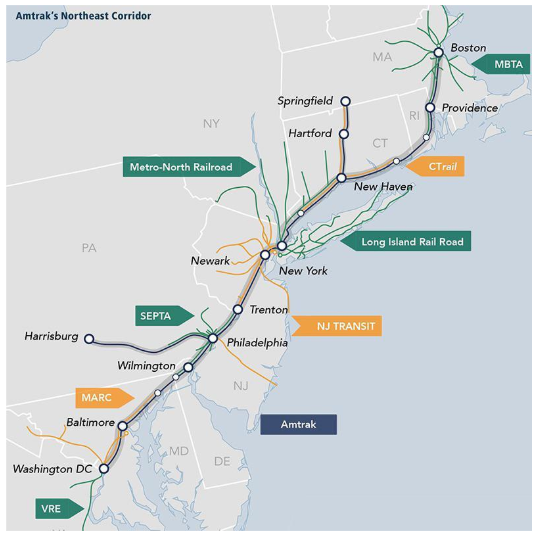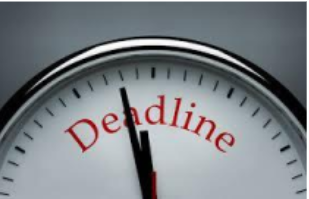In 2000, America’s luxurious high-speed train entered service to act as a superior counterpart for flying. However, it hasn’t quite lived up to its expectations. The Amtrak Acela, America’s fastest passenger train, can be seen zooming down the rails of the Northeast Corridor at a speed of 150 miles per hour in its blue and gray livery. However, the Amtrak Acela travels at this speed for a meager 10 percent of its journey from Boston to Washington. This is one example of how the United States is seriously falling behind in the high-speed rail industry, and there are many factors responsible for this.
The Aging Northeast Corridor
The problems for the Acela haven’t stemmed from the locomotive itself, but from the rails which it travels on. The Northeast Corridor, America’s busiest intercity passenger route that runs between Boston and Washington DC, is in the worst state it’s ever been in. The over-100 year old route is outdated and in need of major updates. Although the Northeast Corridor was not intended to host high-speed rail service, it still lacks the proper infrastructure for a reliable railway. In many places along the Northeast Corridor, tracks are not able to handle speeds higher than 200 miles per hour, putting a significant strain on speed limits. To make matters worse, the Northeast Corridor is poorly designed with many bends and curves which trains have to slowly travel through. Bridges such as the Portal Bridge, which crosses the Hackensack River, and the Dock Bridge, which crosses the Passaic River, haven’t been updated since their construction in the early 1900s. Furthermore, the North River tunnels, the pair of tunnels that carries trains under the Hudson, were also built in the early 1900s and are the origin of many disabled trains that are responsible for extensive delays along the Northeast Corridor. With aspects such as this, a reliable high-speed rail system will be nearly impossible to implement into the country’s aging rails.
No Room for Passenger Rail
The United States has the largest railroad network out of any other country in the world, yet passenger rail services still have little room to operate. Freight lines are the ones to be held accountable for this; they have dominated the rails in the United States. Freight lines are direct competitors of passenger rail, as they take up money and tracks that could be going towards Amtrak and the high-speed rail effort. In addition, CSX and Norfolk Southern, the two prominent freight operators in the east, often conflict with passenger rail service and cause many delays as well as other headaches. According to a CNBC article titled “Why freight railroads are so successful in the U.S.” by Erin Black, “The freight rail network in the U.S. operates over 140,000 miles of privately owned track in every state except for Hawaii.” In comparison, Amtrak only owns just 3 percent of the rail that exists in the United States. As a result of all the effort going into U.S. freight lines, statistics convey that freight lines continue to be profitable, and passenger rail operators continue to lose more money.
Competition Around the World
The United States is miserably losing in the competition for the best high-speed rail network around the globe. For example, China arguably has the most successful high-speed rail service in the world. Their high-speed rail provides reliant transit between China’s major cities at speeds up to 250 miles per hour. China was able to accomplish this mainly because of their ambition to create an efficient high-speed rail network. In addition, they don’t have to worry about conflicts with freight lines nor crumbling infrastructure, unlike the disintegrating Northeast Corridor. Furthermore, train networks around the world have separate high technology tracks that only bullet trains can travel on, leaving the other tracks for commuter and freight service. In order for the U.S. to achieve high-speed rail networks like those of China and others, a greater intent and ambition must be achieved. Otherwise, America will forever be stuck at rock bottom.
Solutions in the Making
Despite all of the problems present in America’s rail system, efforts are being made to turn things around. The main problem being tackled is the rickety infrastructure of the Northeast Corridor. For example, the Gateway Program is a plan in the works to create another tunnel that connects New Jersey to New York under the Hudson. In addition, Amtrak’s overarching plan, CONNECT NEC 2037, will take around 15 years to make the Northeast Corridor more efficient and reliable. The plan will cost $176 billion dollars and sets out to repair century-old infrastructure. The plan also intends to run a higher volume of trains along the Northeast Corridor, which would ultimately draw people in to travel on the rails rather than in the sky or on the roads. Implementing this plan would help towards the cause of defeating climate change, as automobiles and aircrafts are among the leading causes of global warming. Additionally, this major plan has great potential to restore America’s railroad system and possibly make it great again. For now, it brings a sense of hope that America’s rails have not fallen just yet.
The United States originally led the race for the best railroad in the world, but now they are at the completely wrong end of the competition. The Amtrak Acela has clearly not served as America’s trademark high-speed train, but if the current blueprints succeed and the correct ambition is being achieved, the Acela may turn out to be what it set out to become. At no point will the restoration of America’s railroads be easy; it will be a long and hard process. How long do you think it will be until we start seeing bullet trains on the Northeast Corridor? A couple decades? Half a century? Possibly even longer?
Works Cited:
Roche, Daniel Jonas. “Amtrak Has a $176 Billion Plan to Upgrade the Northeast Corridor and Double the Amount of Trains between New York and Washington by 2038.” The Architect’s Newspaper, 1 Dec. 2023, www.archpaper.com/2023/11/amtrak-plan-upgrade-northeast-corridor-double-trains/.
“Shanghai Maglev Train.” Wikipedia, Wikimedia Foundation, 21 Sept. 2024, en.wikipedia.org/wiki/Shanghai_maglev_train.
Black, Erin. “Why Freight Railroads Are so Successful in the U.S.” CNBC, CNBC, 3 Feb. 2022, www.cnbc.com/2022/02/03/why-freight-railroads-are-so-successful-in-the-us.html.
“Northeast Corridor.” Wikipedia, Wikimedia Foundation, 31 Oct. 2024, en.wikipedia.org/wiki/Northeast_Corridor.
Bullet Trains in USA: Why High-Speed Rail System Won’t Work Yet, www.popularmechanics.com/technology/infrastructure/a45025005/bullet-trains-in-usa-high-speed-rail-complications/. Accessed 6 Nov. 2024.
“Dock Bridge.” Wikipedia, Wikimedia Foundation, 6 Sept. 2023, en.wikipedia.org/wiki/Dock_Bridge.
“Portal Bridge.” Wikipedia, Wikimedia Foundation, 16 Oct. 2024, en.wikipedia.org/wiki/Portal_Bridge.
“Acela.” Wikipedia, Wikimedia Foundation, 4 Nov. 2024, en.wikipedia.org/wiki/Acela.
Roche, Daniel Jonas. “Amtrak Has a $176 Billion Plan to Upgrade the Northeast Corridor and Double the Amount of Trains between New York and Washington by 2038.” The Architect’s Newspaper, 1 Dec. 2023, www.archpaper.com/2023/11/amtrak-plan-upgrade-northeast-corridor-double-trains/.
“North River Tunnels.” Wikipedia, Wikimedia Foundation, 21 Oct. 2024, en.wikipedia.org/wiki/North_River_Tunnels.
Jones, Ben. “The Evolution of China’s Incredible High-Speed Rail Network.” CNN, Cable News Network, 9 Feb. 2022, www.cnn.com/travel/article/china-high-speed-rail-cmd/index.html.

 Chords of Our Story: How Music Impacts Our Lives
Chords of Our Story: How Music Impacts Our Lives